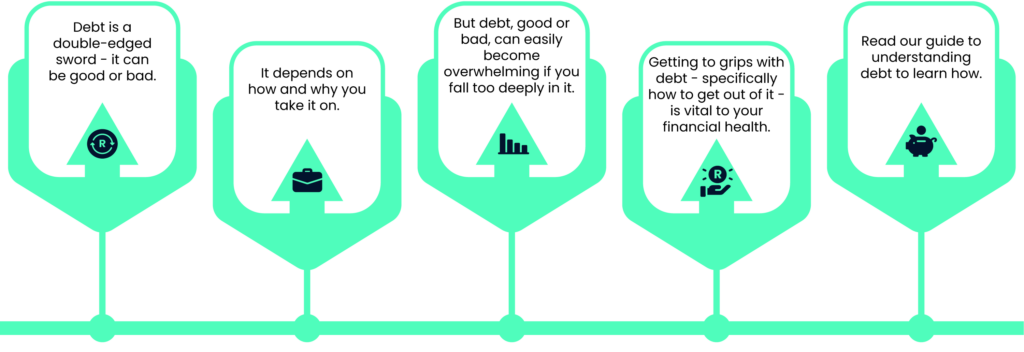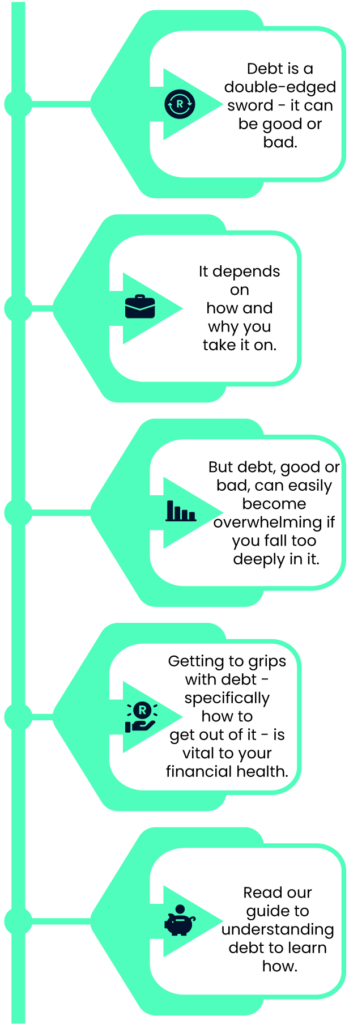Understanding Debt
5 min read


Debt. It’s the ultimate buzzkill. We all wish we had the right kind of stacks we could brag about to family and friends… sadly the only stacks many of us have are that stack of monthly debt repayments piling up.
But debt can be more than a buzzkill. Without a proper plan to address it, debt can snowball and morph into a terrifying monster that chases us down every corner. For many people, being in debt is a scary and overwhelming reality.
If you’re in debt there’s nothing to be ashamed of. Many South Africans are in the same boat. South Africans, on average, spend around 75% of their income on debt repayment. Times are tough and have gotten even tougher over the last two years and we’ve all done what we can to get by.
The important thing is recognising that you’re in debt – and committing to getting yourself out of debt. Today we’re taking a closer look at how to do just that so stick around and find out how you can slay those debt repayment dragons.
The Different Types of Debt
So first things first – what is debt? We interact with it and hear about it daily so much that it’s almost become an abstract concept. In a nutshell, debt is money owed by one party to another party. There are two main types of debt:
- Secured debt – the borrower pledges an asset, such as a car or a house, as collateral for the loan. This means that if the borrower fails to repay their debt as agreed the creditor is allowed to seize the asset.
- Unsecured debt – the borrower does not pledge any asset as collateral. This might sound ideal initially, but you don’t get off the hook if you fail to repay your debt. Often, these creditors will sell your debts to a third-party debt collector who will hound you for the outstanding amount. If you still fail to pay up they might sue you as a result.
Common types of secured debt are car loans and mortgages. If you fail to repay these debts, the creditors will simply seize your car or home. Common types of unsecured debt include credit card debt, medical bill debt and student loans.
Is All Debt Bad?
It might be tempting to write off all debt as bad after hearing all this. But, surprisingly, debt can be both good and bad. It all depends on how you use it and to what end.
Low-interest debt that helps increase your income or net worth can be considered good debt. It’s the type of debt that builds wealth over the long term and leaves you better off than you originally were.
“Good debt” consists of things like student loans (which will help you earn a better income), car loans (which will make daily life easier) and mortgages (which allow you to own a property that will likely increase in value over the years).
Just make sure you understand exactly how much you’ll be expected to pay each month and that you can afford it before committing to any loans.
“Bad debt”, on the other hand, puts pressure on your financial resources for no beneficial reason. Examples of bad debt include debts with high-interest rates, especially when used for luxury or discretionary expenses like a smart TV.
Again, make sure you can afford the monthly repayment instalments before committing to any purchases (if you can pay off more than the minimum each month – even better!).
On the whole, you should try to minimise your “bad” debts as much as possible, as it’s these debts that can quickly add up and trap you in a never-ending repayment cycle.
If you have bad debt, such as an outstanding amount on a credit card, try to pay it off as quickly as possible to avoid incurring interest and penalty fees that will cost you even more.
6 Ways to Master Your Debt
Make the most of your moola
First things first, make sure you have a budget drawn up to help you manage your money if you don’t already. Having parameters in place to help you allocate exactly how much of your monthly income is going to necessary expenses, debt repayments and savings and wants will help you stay on track and ensure you’re not missing any important payment dates.
Know who you owe
If you feel overwhelmed by the amount of debt you’re in, a great way to regain a sense of control is to list exactly how much you owe and to whom. Creating a spreadsheet can help you stay up to date on your debts including total amounts outstanding, minimum monthly repayment amounts and deadlines.
Begin with the biggest
If you have multiple debts, you’ll need to prioritise which ones you should pay off first. Some types of debt carry much higher interest rates than others, so it’s best to target debts that have the highest interest and ones costing you the most. Pay the most expensive debts off as quickly as possible and then tackle the lower-interest and less expensive debts.
Consider some side hustles
Got skills? Now’s the time to put them to work! Working a few extra hours online or picking up a side job can help you to pay off outstanding debts more quickly. Sure it’s a drag now, but try to think how worthwhile it will be when you’re debt-free that much sooner! If taking on a second job or side hustle is absolutely off the cards, consider what else you can do to earn a little extra dosh like selling some old clothes.
Curb your (spending) enthusiasm
But if you’re in debt, the best thing you can do is cut back on any unnecessary expenses like eating out or going on vacation. No one wants to hear this – including us! That extra money you save can funnel back into your debt repayment, paying it off faster and ultimately lowering the amount you’ll pay.
Consider consolidation
Debt consolidation means taking out a new loan to pay off multiple debts at the same time. Consolidated loans generally offer lower interest rates and monthly repayment rates, so can be an amazing way to knock off large amounts of outstanding debt in one go.
This shouldn’t be your first option though, as you’re essentially getting yourself into more debt to pay off your debt. Be careful too – if you don’t trust your spending impulses that consolidation loan might end up funding an entirely new purchase.
Conclusion
I’ve annihilated all my debt – what now?
First off, congratulations! It’s a great feeling, isn’t it? If you’re still on your way there, don’t be discouraged – you’ll get there! Having a plan in place is the first step. Sticking to it is the second.
The third step is taking a look at your current lifestyle and making some important changes that will prevent you from getting back into debt in the future.
Whether it’s cancelling that credit card, cutting back on luxury spending or finding a more affordable place to crash, making those adjustments will be uncomfortable at first – but they will pay off so you won’t have to anymore.
The content provided in this article is provided as general information. It is not intended as nor does it constitute financial, tax, legal, investment, or other advice. We accept no responsibility from any loss arising as a result of your reliance on information contained in this article, any related communication or on our app.